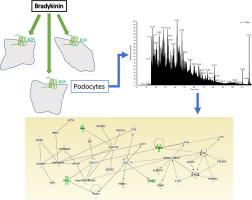Journal of Advanced Research ( IF 11.4 ) Pub Date : 2020-05-28 , DOI: 10.1016/j.jare.2020.05.021 Richard Saoud 1 , Miran A Jaffa 2 , Aida Habib 1, 3 , Jingfu Zhao 4 , Moustafa Al Hariri 1 , Rui Zhu 4 , Anwarul Hasan 5 , Fuad N Ziyadeh 1, 6 , Firas Kobeissy 1 , Yehia Mechref 4 , Ayad A Jaffa 1

|
Podocyte damage is one of the hallmarks of diabetic nephropathy leading to proteinuria and kidney damage. The underlying mechanisms of podocyte injury are not well defined. Bradykinin (BK) was shown to contribute to diabetic kidney disease. Here, we evaluated the temporal changes in proteome profile and inflammatory signals of podocytes in response to BK (10−7M). Protein profile was evaluated by liquid chromatography mass Spectrometry (LC-MS/MS) analysis. Proteome profile analysis of podocytes treated with BK (10−7M) for 3 and 6 h, revealed 61 proteins that were differentially altered compared to unstimulated control podocytes. Pathway enrichment analysis suggested inhibition of cell death pathways, engagement of cytoskeletal elements and activation of inflammatory pathways. One of the inflammatory proteins that was identified to be induced by BK treatment is Prostaglandin (PG) H Synthase-2 (Cyclooxygenase-2, COX-2). In addition, BK significantly induced the production and release of PGE2 and this effect was inhibited by both COX-2 and MEK Kinase inhibitors, demonstrating that the production of PGE2 by BK is mediated via COX-2 and MAPK-dependent mechanisms. These findings provide a global understanding of the effector modulated proteome in response to BK and also reveal BK as an important modulator of inflammation and a potential player in podocyte injury.
中文翻译:

缓激肽在足细胞中对蛋白质组学和炎症信号的调节。
足细胞损伤是导致蛋白尿和肾脏损伤的糖尿病性肾病的标志之一。足细胞损伤的潜在机制尚不清楚。缓激肽(BK)被证明可导致糖尿病肾病。在这里,我们评估了蛋白质组概况和足细胞响应BK(10 -7 M)的炎症信号的时间变化。通过液相色谱质谱法(LC-MS / MS)分析评估蛋白质谱。BK处理足细胞的蛋白质组谱分析(10 -7M)持续3和6小时,发现61种蛋白质与未刺激的对照足细胞相比差异性改变。途径富集分析表明抑制细胞死亡途径,参与细胞骨架成分和激活炎症途径。被确定为可通过BK治疗诱导的一种炎症蛋白是前列腺素(PG)H合酶2(环氧合酶2,COX-2)。此外,BK显着诱导了PGE 2的产生和释放,并且该作用被COX-2和MEK激酶抑制剂均抑制,表明PGE 2的产生。BK的作用是通过COX-2和MAPK依赖性机制介导的。这些发现提供了对响应于BK的效应物调节的蛋白质组的全面了解,并且还揭示了BK是炎症的重要调节剂和足细胞损伤的潜在参与者。











































 京公网安备 11010802027423号
京公网安备 11010802027423号